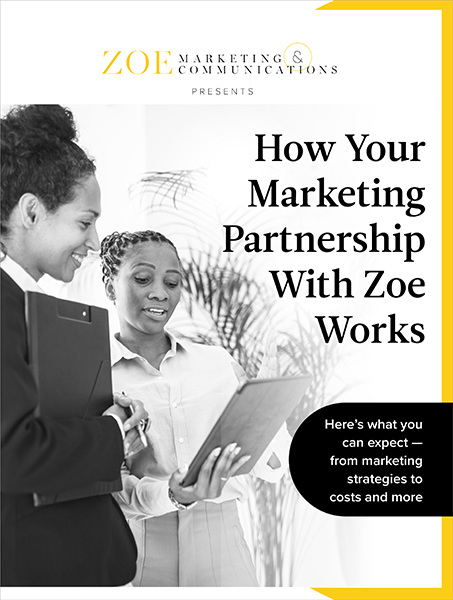
Download Your Guide to Marketing With Zoe
From the first steps and your role in success to specific services, pricing and success stories, learn all about partnering with Zoe.

Looking to attract new customers, convert them or keep them coming back? If you’re like most businesses, you’re doing all three — at once, all the time.
That’s the essence of full-funnel marketing. It acknowledges that prospects don’t move in a straight line. Instead, they explore, engage and decide on their own terms.
Managing this can feel overwhelming. That’s where we come in. At Zoe Marketing & Communications, we help businesses streamline their marketing funnel so it’s effective and manageable.
In this guide, we’ll break down the funnel into three core stages — attract, engage and delight — and the best tactics to use at each.
From the first steps and your role in success to specific services, pricing and success stories, learn all about partnering with Zoe.
A full-funnel strategy ensures you’re always reaching people at different points in their journey. At any given time, you’re:

This approach requires different tactics depending on where your audience is in the funnel.
At this stage, your goal is visibility. You want to grab attention, introduce your brand and spark interest.
When people have a problem, they Google it. Paid Google Ads (SEM) put you in front of them when they search for related solutions.
Blogging and educational content attract customers organically. The key? Answer their questions. Create high-quality, helpful content that aligns with their needs.
Your prospects are scrolling. Be where they are. Meta (Facebook/Instagram) is dominant, but consider YouTube, LinkedIn, Pinterest or wherever your audience spends time.
Once someone clicks your ad, don’t disappoint them. Your landing page should be:
Now they know you exist — but they’re still deciding. Your job is to build trust and guide them forward.
Offer something valuable in exchange for an email. Examples:
Once you’ve captured emails, nurture the relationship.
If they’ve visited your site but haven’t converted, stay top of mind.
Once they’ve bought from you, the job isn’t done. Keep them engaged so they return — and tell others.
Customers expect immediate responses. Chat tools help:
Reward repeat customers with:
A full-funnel approach ensures you’re attracting, engaging and delighting customers — keeping your brand top of mind at every stage.
Want to fill your funnel? Talk to us at Zoe Marketing & Communications. We’ll help you create a strategy that works without overwhelming you.
To learn more about healthy digital marketing, check out these resources:

From the first steps and your role in success to specific services, pricing and success stories, learn all about partnering with Zoe.
As Zoe Marketing & Communications’ content manager, Kim Kovelle brings over 20 years of writing and editing experience in metro Detroit. She has strong roots in community journalism and a knack for making complicated topics make more sense.
